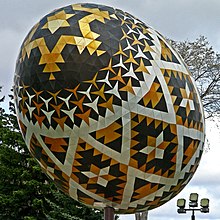Ron Resch: Difference between revisions
Content deleted Content added
Citation bot (talk | contribs) Alter: url. URLs might have been anonymized. Add: chapter-url, chapter-url-access, year, date, isbn, authors 1-3. Removed or converted URL. Removed parameters. Some additions/deletions were parameter name changes. | Use this bot. Report bugs. | Suggested by AManWithNoPlan | #UCB_webform 1246/2199 |
|||
| Line 8: | Line 8: | ||
}} |
}} |
||
'''Ron Resch''' (Ronald Dale Resch) was an artist, computer scientist, and applied geometrist, known for his work involving folding paper, [[Origami#Origami tessellations|Origami Tessellations]] and 3D polyhedrons.<ref name="Unfolded">{{cite book | url=https://books.google.com/books?id=JPVEfrWnPwYC |
'''Ron Resch''' (Ronald Dale Resch) was an artist, computer scientist, and applied geometrist, known for his work involving folding paper, [[Origami#Origami tessellations|Origami Tessellations]] and 3D polyhedrons.<ref name="Unfolded">{{cite book | url=https://books.google.com/books?id=JPVEfrWnPwYC&dq=ron+resch&pg=PA136 | title=Unfolded: Paper in Design, Art, Architecture and Industry | isbn=9783034609050 | accessdate=13 November 2013| last1=Schmidt | first1=Petra | last2=Stattmann | first2=Nicola | date=5 November 2012 }}</ref><ref name="matrix">{{cite book | url=https://books.google.com/books?id=RDv-iZk-ptkC&dq=ron+resch&pg=PT140 | title=The Mereon Matrix: Unity, Perspective and Paradox | isbn=9780124046887 | accessdate=13 November 2013| last1=Dennis | first1=Lynnclaire | last2=McNair | first2=Jytte Brender | last3=Kauffman | first3=Louis H. | date=21 May 2013 }}</ref><ref>{{cite book | url=https://books.google.com/books?id=tz76s0ZGFiQC&dq=ron+resch&pg=PA336 | title=Connections: The Geometric Bridge Between Art and Science| isbn=9789812811394| last1=Kappraff| first1=Jay| year=2001}}</ref><ref>{{cite book | url=https://books.google.com/books?id=pW_0EisSP4IC&dq=ron+resch&pg=PA117 | title=Hinged Dissections: Swinging and Twisting| isbn=9780521811927| last1=Frederickson| first1=Greg N.| date=26 August 2002}}</ref> |
||
<ref>{{cite book | url=https://books.google.com/books?id=r-k4GSYaV5YC |
<ref>{{cite book | url=https://books.google.com/books?id=r-k4GSYaV5YC&dq=ron+resch&pg=PA456 | title=Origami 5: Fifth International Meeting of Origami Science, Mathematics, and| isbn=9781568817149| last1=Wang-Iverson| first1=Patsy| last2=Lang| first2=Robert J.| date=21 June 2011}}</ref><ref>{{cite book | url=https://books.google.com/books?id=I1fj_B60fyoC&dq=ron+resch&pg=PA332 | title=The Mathematical Experience, Study Edition| isbn=9780817682941| last1=Davis| first1=Philip| last2=Hersh| first2=Reuben| last3=Marchisotto| first3=Elena Anne| date=27 October 2011}}</ref><ref name="mathbook-1991">{{cite book|author1=Richard Rhoad|author2=George Milauskas|author3=Robert Whipple|name-list-style=amp|title=Geometry: for Enjoyment and Challenge|publisher=[[Mc Dougal Littell]]/[[Houghton Mifflin]]|year=1991|edition=new|pages=[https://archive.org/details/geometryforenjoy00geor/page/318 318]|chapter=7 - Polygons: Regular Polygons|isbn=978-0-86609-965-3|chapter-url-access=registration|chapter-url=https://archive.org/details/geometryforenjoy00geor/page/318}}</ref> |
||
Resch studied art at the [[University of Iowa]] receiving his [[Master of Fine Arts]], and went on to become a professor of [[Computer Science]] at the [[University of Utah]].<ref>{{cite book | url=https://books.google.com/books?id=SuVUAAAAMAAJ&q=ron+resch |
Resch studied art at the [[University of Iowa]] receiving his [[Master of Fine Arts]], and went on to become a professor of [[Computer Science]] at the [[University of Utah]].<ref>{{cite book | url=https://books.google.com/books?id=SuVUAAAAMAAJ&q=ron+resch | title=Studio Potter | year=1981 | publisher=Daniel Clark Foundation | accessdate=13 November 2013}}</ref> |
||
He famously designed the [[Vegreville egg]], the first physical structure designed entirely with computer-aided geometric modelling software. |
He famously designed the [[Vegreville egg]], the first physical structure designed entirely with computer-aided geometric modelling software. |
||
Revision as of 09:45, 4 December 2021
Ron Resch | |
|---|---|
 Vegreville egg | |
| Born | Ronald Dale Resch 1939 |
| Died | November 24, 2009 (aged 70) |
Ron Resch (Ronald Dale Resch) was an artist, computer scientist, and applied geometrist, known for his work involving folding paper, Origami Tessellations and 3D polyhedrons.[1][2][3][4] [5][6][7]
Resch studied art at the University of Iowa receiving his Master of Fine Arts, and went on to become a professor of Computer Science at the University of Utah.[8]
He famously designed the Vegreville egg, the first physical structure designed entirely with computer-aided geometric modelling software.
References
- ^ Schmidt, Petra; Stattmann, Nicola (5 November 2012). Unfolded: Paper in Design, Art, Architecture and Industry. ISBN 9783034609050. Retrieved 13 November 2013.
- ^ Dennis, Lynnclaire; McNair, Jytte Brender; Kauffman, Louis H. (21 May 2013). The Mereon Matrix: Unity, Perspective and Paradox. ISBN 9780124046887. Retrieved 13 November 2013.
- ^ Kappraff, Jay (2001). Connections: The Geometric Bridge Between Art and Science. ISBN 9789812811394.
- ^ Frederickson, Greg N. (26 August 2002). Hinged Dissections: Swinging and Twisting. ISBN 9780521811927.
- ^ Wang-Iverson, Patsy; Lang, Robert J. (21 June 2011). Origami 5: Fifth International Meeting of Origami Science, Mathematics, and. ISBN 9781568817149.
- ^ Davis, Philip; Hersh, Reuben; Marchisotto, Elena Anne (27 October 2011). The Mathematical Experience, Study Edition. ISBN 9780817682941.
- ^ Richard Rhoad; George Milauskas & Robert Whipple (1991). "7 - Polygons: Regular Polygons". Geometry: for Enjoyment and Challenge (new ed.). Mc Dougal Littell/Houghton Mifflin. pp. 318. ISBN 978-0-86609-965-3.
- ^ Studio Potter. Daniel Clark Foundation. 1981. Retrieved 13 November 2013.
External links
- The Ron Resch Paper and Stick Film
- Ron Resch Official Web Site (restored recently)
- Some of Resch's works
